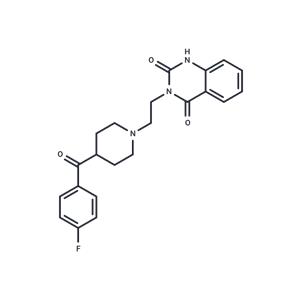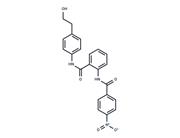| Name | Ketanserin |
| Description | Ketanserin (Ketanserinum) is a quinazoline derivative and serotonin (5-hydroxytryptamine, 5HT) receptor subtype 2 (5-HTR2) antagonist with potential antihypertensive and antiplatelet activities. Following administration, ketanserin binds to and inhibits the signaling mediated by 5-HTR2, which inhibits serotonin-dependent vasoconstriction and platelet activation. |
| Cell Research | Ketanserin is dissolved in DMSO to produce a stock solution of 100 mM. Ketanserin stock is diluted in experimental solutions to achieve the final concentrations[1]. The established HEK 293 cell line stably expressing hERG channels is cultured in Dulbecco's modified Eagle's medium (DMEM) supplemented with 10% foetal bovine serum, 400 μg/mL G418. The HEK 293 cell line stably expressing recombinant human cardiac KCNQ1/KCNE1 channel current (IKs) is maintained in DMEM containing 10% foetal bovine serum and 100 μg/mL hygromycin. Cells used for electrophysiology are seeded on a glass coverslip. The mutant hERG channels are constructed, and are transiently expressed in HEK 293 cells using 10 μL of Lipofectamine 2000 with 4 μg of hERG mutant cDNA in pCDNA3 vector[1]. |
| In vitro | In the acetic acid-induced writhing and hot plate tests, ketanserin exhibited dose-dependent analgesic effects in rats, with ED50 values of 0.62 mg/kg and 1.51 mg/kg, respectively; however, it showed no effect on the tail flick test. |
| In vivo | Research has demonstrated that Ketanserin reduces both the α1-adrenergic receptor-mediated responses and the excitation caused by norepinephrine in the lateral geniculate nucleus. This effect is indicative of induced inhibition rather than attenuation of 5-HT-mediated responses. In isolated rat tail and carotid arteries, dog basilar, gastric splenic and coronary arteries, as well as canine hidden veins and gastric splenic veins, Ketanserin dose-dependently inhibits the contraction induced by 5-hydroxytryptamine (5-HT). In rat cardiac myocytes, Ketanserin significantly prolongs the action potential duration, with repolarization reaching 218% at 50% and 256% at 90%, without significantly affecting other action potential parameters. Ketanserin inhibits the contraction of canine hidden veins and rat tail arteries induced by the activation of postsynaptic α-adrenergic receptors. In addition, Ketanserin inhibits the contractile response to 5-HT in perfused guinea pig gastric vessels and can reverse the response in some experiments. Ketanserin inhibits the transient outward potassium current (Ito) in a time- and concentration-dependent manner (EC50: 8.3 μM) and also dose-dependently inhibits both Ito and sustained currents (EC50: 11.2 μM), but does not affect L-type calcium currents or inward rectifier potassium currents. |
| Storage | Powder: -20°C for 3 years | In solvent: -80°C for 1 year | Shipping with blue ice. |
| Solubility Information | DMSO : 9 mg/mL (22.76 mM)
|
| Keywords | 5-HT Receptor | R 41468 | Ketanserin Tartrate | KcsA | inhibit | Potassium Channel | R-41468 | Ketanserin | Serotonin Receptor | Autophagy | Inhibitor | 5-hydroxytryptamine Receptor |
| Inhibitors Related | Hydroxychloroquine | Guanidine hydrochloride |
| Related Compound Libraries | Pain-Related Compound Library | Bioactive Compound Library | Membrane Protein-targeted Compound Library | Anti-Cancer Clinical Compound Library | Anti-Cancer Approved Drug Library | GPCR Compound Library | Anti-Cancer Drug Library |

 United States
United States



